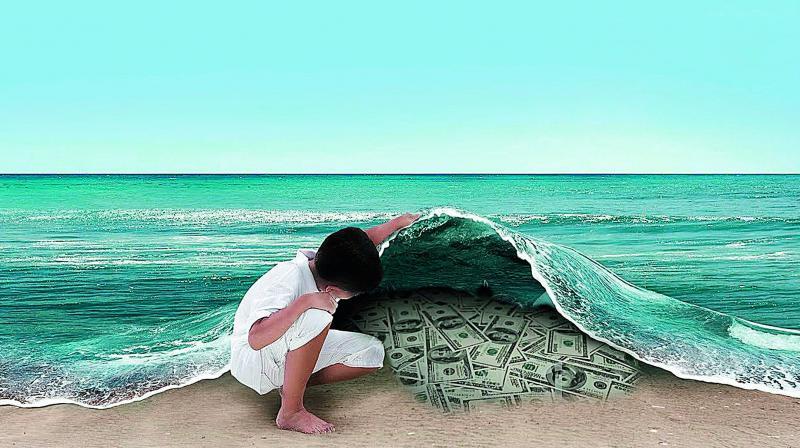Ocean of hope: Time we explored the blue economy

Human beings, since the beginning of civilisation, have depended on oceans for food, and later for trading and exploring the ‘New World’. Our dependence on the oceans for food and energy has been increasing. The term ‘Blue Economy’ has been coined to emphasise an ocean-dependent economic development. However, the Blue Economy is not only economic development but should also ensure inclusive social development as well as environmental and ecological security.
The main objective of the Blue Economy should be to improve quality of life of people. This definition certainly imposes certain limitations on technology-based economic development and reminds us about our social obligations to protect and conserve coastal and marine ecosystems. We also need to understand the ability of the earth system to absorb effects of such anthropogenic activities and to synchronise with the sustainable development goals (SDGs).
The first step is to ensure that we have adequate information about seabed and mineral resources, fishery resources and sea state in our Exclusive Economic Zone (EEZ), which covers 2 million sq. km of area. Under the UN Convention on the Law of the Sea (UNCLOS), our rights on the seabed can extend up to 350 nautical miles, especially on our continental shelf. India has already submitted partial claim of about 0.6 million sq. km to the Commission of Legal Continental Shelf (CLCS). The second claim of about 0.6 sq. km is yet to be submitted. Thus, it is likely that our rights on the seabed will increase from 2 million to 3.2 million sq. km in the near future. Detailed bathymetric, geological and geophysical surveys have been initiated to estimate availability of mineral and energy resources.
Currently, our annual marine fish production is around 4 million tonnes. Many new deep-sea fishery grounds between 200 metres to 1,000 metres have been identified. Recently, a new fishery resource, myctophids, having potential of almost 100 million tonnes, has been located.
There is good potential to use myctophids as food for livestock, poultry and aquatics. Experiments on cage-culture and ornamental fisheries have been demonstrated successfully near Rameshwaram and in the Lakshadweep Islands, respectively. Technological challenges on harvesting, post-harvesting and product development need to be undertaken for successful commercial ventures. We also need to look for minerals in the deep sea.
The exploration in the Central Indian Ocean for manganese nodules has proved reserves of 380 million metric tonnes of nodules having strategic minerals such as copper, nickel and cobalt and other noble minerals. The exploration of hydrothermal systems along mid-oceanic ridges and cobalt-crusts is continuing.
The availability of gas hydrates needs to be fully explored. It has huge potential to satisfy our ever-increasing energy requirements. We need to invest in developing technology and human resources to utilise these resources.
All developmental activities along the coast will require freshwater, which is scarce. Freshwater from the sea is a very attractive solution; however, plants based on reverse osmosis technology are environmentally unfriendly.
Low Temperature Thermal Desalination, an environment friendly technology that utilises natural ocean thermal gradient, is found to be suitable for this purpose. Small plants have been successfully operated since the last 10 years or so on the Lakshadweep Islands. The challenge is to set up offshore plants having the capability to generate freshwater of 10 million s per day, by designing suitable seawater intake and ocean platforms.
The coast is also vulnerable to many hazards such as cyclones, storm surges, tsunamis, coastal erosion, sea level rise, etc. The available coastal vulnerability maps should be used to understand risks involved, and accordingly, developmental activities should be planned. Information on sea state is required for economic activities such as shipping, fishing, oil and gas production.
Numerical models have been customised to forecast waves, ocean currents, sea surface temperature, etc. on a daily basis. We need to improve reliability and accuracy of these forecasts. We need to continue our investments in satellite-based and in situ observations on various ocean parameters such as temperature, salinity, waves, currents, etc. We also need to preserve our coastal ecosystems, while carrying out developmental activities. Regular satellite-based monitoring of such ecosystems is a vital requirement.
We also need to build effective communications with various stakeholders including policy makers. The scope and objectives of such development should be relevant to society. The implementation strategy, including institutional mechanism, financing, etc., should be specified and agreed upon. The responsible stewardship of oceans is an investment that will pay dividends for generations to come. We need to renew our commitments to oceans especially to ensure sustainability of coasts and oceans and thus of the planet Earth, for the benefit of mankind.
(Dr Shailesh Nayak is Director, National Institute of Advanced Studies, IISc Campus, Bangalore)

